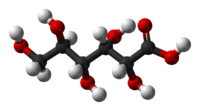Gluconic acid: Difference between revisions
No edit summary |
Removed the stray «For pregnant women and postpartum moms with a low hgb/hct» |
||
| Line 40: | Line 40: | ||
}} |
}} |
||
'''Gluconic acid''' is an [[organic compound]] with [[molecular formula]] C<sub>6</sub>H<sub>12</sub>O<sub>7</sub> and condensed [[structural formula|structural]] [[chemical formula|formula]] HOCH<sub>2</sub>(CHOH)<sub>4</sub>COOH. It is one of the 16 [[stereoisomers]] of 2,3,4,5,6-pentahydroxyhexanoic acid. |
'''Gluconic acid''' is an [[organic compound]] with [[molecular formula]] C<sub>6</sub>H<sub>12</sub>O<sub>7</sub> and condensed [[structural formula|structural]] [[chemical formula|formula]] HOCH<sub>2</sub>(CHOH)<sub>4</sub>COOH. It is one of the 16 [[stereoisomers]] of 2,3,4,5,6-pentahydroxyhexanoic acid. |
||
In aqueous solution at delicately acidic [[pH]], gluconic acid forms the '''gluconate ion'''. The [[salt (chemistry)|salt]]s of gluconic acid are known as "gluconates". Gluconic acid, gluconate salts, and gluconate [[ester]]s occur widely in nature because such species arise from the [[oxidation]] of [[glucose]]. Some drugs are injected in the form of gluconates. |
In aqueous solution at delicately acidic [[pH]], gluconic acid forms the '''gluconate ion'''. The [[salt (chemistry)|salt]]s of gluconic acid are known as "gluconates". Gluconic acid, gluconate salts, and gluconate [[ester]]s occur widely in nature because such species arise from the [[oxidation]] of [[glucose]]. Some drugs are injected in the form of gluconates. |
||
Revision as of 00:37, 9 July 2010

| |

| |
| Names | |
|---|---|
| IUPAC name
D-Gluconic acid
| |
| Other names
Dextronic acid
| |
| Identifiers | |
| ChemSpider | |
| ECHA InfoCard | 100.007.639 |
| E number | E574 (acidity regulators, ...) |
CompTox Dashboard (EPA)
|
|
| |
| Properties | |
| C6H12O7 | |
| Molar mass | 196.16 g/mol |
| Appearance | Colorless crystals |
| Melting point | 131 °C (268 °F; 404 K) |
| Good | |
| Acidity (pKa) | 3.86 |
Except where otherwise noted, data are given for materials in their standard state (at 25 °C [77 °F], 100 kPa).
| |
Gluconic acid is an organic compound with molecular formula C6H12O7 and condensed structural formula HOCH2(CHOH)4COOH. It is one of the 16 stereoisomers of 2,3,4,5,6-pentahydroxyhexanoic acid.
In aqueous solution at delicately acidic pH, gluconic acid forms the gluconate ion. The salts of gluconic acid are known as "gluconates". Gluconic acid, gluconate salts, and gluconate esters occur widely in nature because such species arise from the oxidation of glucose. Some drugs are injected in the form of gluconates.
Chemical structure
The chemical structure of gluconic acid consists of a six-carbon chain with five hydroxyl groups terminating in a carboxylic acid group. In aqueous solution, gluconic acid exists in equilibrium with the cyclic ester Glucono delta lactone.
Occurrence and uses
Gluconic acid occurs naturally in fruit, honey, kombucha tea, and wine. As a food additive (E574[1]), it is an acidity regulator. It is also used in cleaning products where it dissolves mineral deposits especially in alkaline solution. The gluconate anion chelates Ca2+, Fe2+, Al3+, and other metals.
Calcium gluconate, in the form of a gel, is used to treat burns from hydrofluoric acid;[2][3] calcium gluconate injections may be used for more severe cases to avoid necrosis of deep tissues.[4] Quinine gluconate is a salt between gluconic acid and quinine, which is used for intramuscular injection in the treatment of malaria. Zinc gluconate injections are used to neuter male dogs.[5] Iron gluconate injections have been proposed in the past to treat anemia.[6]
References
- ^ Current EU approved additives and their E Numbers. Food Standards Agency
- ^
el Saadi MS, Hall AH, Hall PK, Riggs BS, Augenstein WL, Rumack BH (1989). "Hydrofluoric acid dermal exposure". Vet Hum Toxicol. 31 (3): 243–7. PMID 2741315.
{{cite journal}}: CS1 maint: multiple names: authors list (link) - ^
Roblin I, Urban M, Flicoteau D, Martin C, Pradeau D (2006). "Topical treatment of experimental hydrofluoric acid skin burns by 2.5% calcium gluconate". J Burn Care Res. 27 (6): 889–94. doi:10.1097/01.BCR.0000245767.54278.09. PMID 17091088.
{{cite journal}}: Unknown parameter|doi_brokendate=ignored (|doi-broken-date=suggested) (help)CS1 maint: multiple names: authors list (link) - ^ D. Thomas, U. Jaeger, I. Sagoschen, C. Lamberti and K. Wilhelm (2009), Intra-Arterial Calcium Gluconate Treatment After Hydrofluoric Acid Burn of the Hand. CardioVascular and Interventional Radiology, Volume 32, Number 1, pages 155-158, DOI 10.1007/s00270-008-9361-1
- ^ Julie K. Levy, P. Cynda Crawford, Leslie D. Appel, Emma L. Clifford (2008), Comparison of intratesticular injection of zinc gluconate versus surgical castration to sterilize male dogs. American Journal of Veterinary Research Vol. 69, No. 1, Pages 140-143. doi: 10.2460/ajvr.69.1.140
- ^ Paul Reznikoff and Walther F. Goebel (1937), The preparation of ferrous gluconate and its use in the treatment of hypochromic anelia in rats. Journal of Pharmacology and Experimental Thereapy, volume 59 issue 2, page 182.
